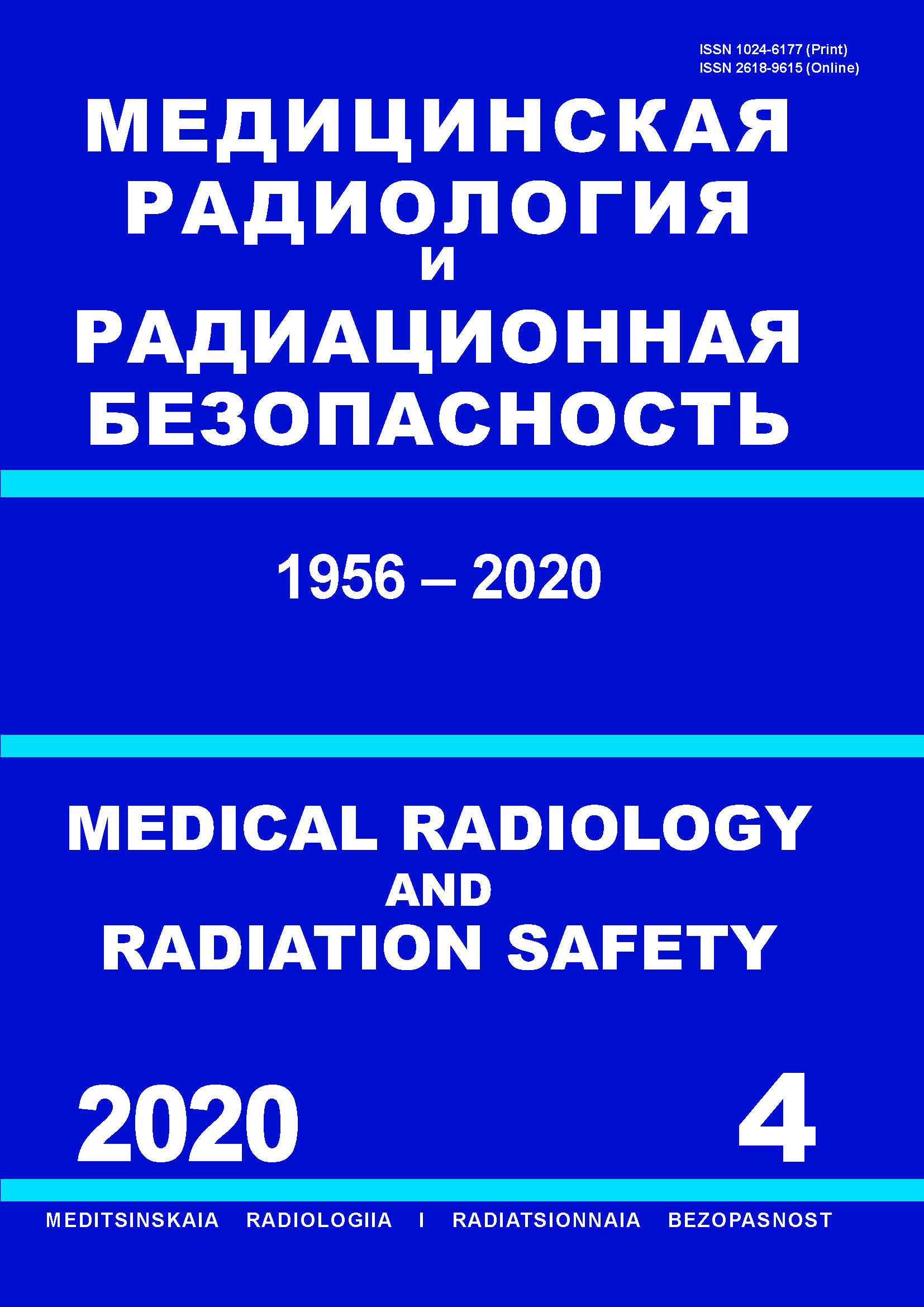VAK Russia 14.02.2004
UDC 61
CSCSTI 76.29
Russian Classification of Professions by Education 31.02.04
Russian Classification of Professions by Education 31.06.2001
Russian Classification of Professions by Education 31.07.01
Russian Library and Bibliographic Classification 54
Russian Library and Bibliographic Classification 56
Russian Library and Bibliographic Classification 57
Russian Library and Bibliographic Classification 58
Russian Trade and Bibliographic Classification 573
Russian Trade and Bibliographic Classification 5734
BISAC MED080000 Radiology, Radiotherapy & Nuclear Medicine
Purpose: To find the distinctive features of the white matter tracts’ structural changes for Chernobyl accident liquidators with ebcephalopathy at the remote period using DT-MRI methods. Material and methods: Chernobyl accident liquidators group (41 subjects) and group of control (49 subjects), all subjects with stage II of encephalopathy, mean age of liquidators’ group 68.3 ± 6.9 years, gropup of control — 68.6 ± 5.8 years. All subjects were clinically examined to confirm encephalopathy stage, hypertension, diabetes (and prove patients of both groups have comparable level of damage of those deseases), as well as with routine MRI and DT-MRI protocols. According routine MRI results, all subjects of both groups had high level of discirculatory damages: multifocal lesions of white matter and periventricular leukoaraiosis, mixed replacement hydrocephalus. Results: Liquidator’s group average fraction anisotropy coefficient (CFA) had shown statistically significant reduction in four frontal and temporal lobe tracts of neocortex if compare with average CFA in the group of control: superior longitudinal fasciculi (р < 0.02); front sections of corona radiata (р < 0.02); anterior horn of internal capsule (р < 0.01), inferior longitudinal fasciculi (р < 0.01). Conclusion: Frontal and temporal lobe tracts of neocortex, responsible for cognitive processes, are the most sensible to accident liquidation negative factors. Cerebral structure changes, found for group of liquidators, are similar to elder people with encephalopathy, but are clnically more strongly marked, what proves hyoptesis of early aging of liquidators’ brain structures.
nuclear accidents, Chernobyl Nuclear Power Plant, Chernobyl accident liquidator, diffusion-tensor MRI (DT‑MRI), fraction anysotropy (FA), cognitive disorders, discirculatory encephalopathy
1. Podsonnaia IV, Efremushkin GG, Zhelobetskaia ED. The bioelectric activity of the brain in discirculatory encephalopathy and arterial hypertension developed in the Chernobyl nuclear disaster liquidators. S.S. Korsakov J Neurol Psychiatry. 2012;10:33-8 (In Russ.).
2. Bychkovskaya IB, Giliano NYa, Fedortseva RF, Bedcher FS. About special form of radiation instability. Radiation Biology. Radioecology. 2005;47(6):688-93. (In Russ.).
3. Levashkina IM, Aleksanin SS, Serebryakova SV, Gribanova TG. Low and mean radiation doses impact on the cerebral tracts structure of the Chernobyl accident liquidators in the remote period (based on routine and diffusion-tensor magnetic resonance imaging data). Radiation Hygiene. 2017;10(4):23-30. (In Russ.).
4. Ushakov IB, Bubeev YuA. Stress of deathful conditions as a special kind of stress. Medico-Biological and Socio-Psychological Problems of Safety in Emergency Situations. 2011;(4):5-8 (In Russ.).
5. Igoshina TV. Psychophysiological rationale for the use of the xenon inhalation method for the correction of neurotic stress-related disorders in persons with dangerous occupations [dissertation]. Moscow. 2017. 147 p. (In Russ.).
6. Ushakov IB, Fyodorov VP. Impact of Chernobyl Accident Factors on Psychoneurological Status of Liquidators - Helicopter-Pilots. Medical Radiology and Radiation Safety. 2018;63(4):22-32. (In Russ.).
7. Hovhannisyan NM, Karapetyan AG. The remote medical consequences of failure on Chernobyl NPP: biological age and quality of the life of liquidators. Medical and Biological Problems of Life Activity. 2014;1(11):90-7. (In Russ.).
8. Kitaev SV, Popova TA. Principles of diffusion tensor imaging and its application to neuroscience. Annals of Clinical and Experimental Neurology. 2012;6(1):48-53. (In Russ.).
9. Viviano RP, Hayes JM, Pruitt P, Fernandez ZJ, van der Grond J, et al. Aberrant memory system connectivity and working memory performance in subjective cognitive decline. NeuroImage. 2018. DOI: doi.org/10.1016/j.neuroimage. 2018.10.015.
10. Levashkina IM, Serebryakova SV, Tikhomirova OV, Kitaigorodskaya EV. Threshold fraction anisotropy level and vascular dementia prediction for subjects with diagnosed encephalopathy. Diagnostic radiology and radiotherapy. 2019;2:59-65. (In Russ.).
11. Mori S, Wakana S, Nagae-Poetscher LM, Van Zijl PCM.MRI atlas of human white matter. Elsevier. 2010. 284 p.
12. Zakszewski E, Adluru N, Tromp do PM, Kalin N, Alexander AL. A diffusion-tensor-based white matter atlas for rhesus macaques. PLoS ONE. 2014;9(9). DOI:https://doi.org/10.1371/journal.pone.0107398.
13. Catani M, Thiebaut de Schotten M. A diffusion tensor imaging tractography atlas for virtual in vivo dis-sections. Cortex. 2008;44(8):1105-32. DOI:https://doi.org/10.1016/j.cortex.2008.05.004.
14. Liu J, Liang P, Yin L, Shu N, Zhao T, Xing Y, et al. White Matter Abnormalities in Two Different Subtypes of Amnestic Mild Cognitive Impairment. PLoS One. 2017;12(1). DOI:https://doi.org/10.1371/journal.pone.0170185.
15. Serebryakova SV, Aleksanin SS, Levshkina IM, eds. Cognitive decline risk and the consequenses assessment for Chernobyl accident liquidators with diagnosed encephalopathy using diffusion-tensor MRI. 1st ed. St.-Petersburg: The Nikiforov Russian Center of Emergency and Radiation Medicine EMERCOM of Russia; 2019. 34 p. (In Russ.).





